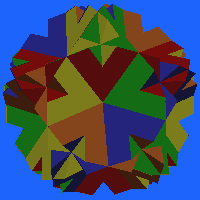Polyhedra with Equal Faces and Equal Vertex Figures
Interestingly, the nine regular solids are not the only polyhedra with equal faces and equal vertex figures. They would be if we required the faces to be regular polygons, but if we allow irregular polygons, a number of other examples are known.
If you "stretch" a regular tetrahedron by pulling two opposite edges apart while keeping them orthogonal, the result is a kind of tetragonal disphenoid. It has four congruent isosceles faces. If you "squish" rather than stretch, you get one like this.
If you also rotate the two opposite edges relative to each other about their common 2-fold axis, the result is a rhombic disphenoid. It has four congruent scalene faces. At each vertex, one of each type of face angle meets.
In both cases, the disphenoid has a net which is a triangle with edge lengths twice those of a face, divided (at the three edge midpoints) into four congruent triangles (the central one being "upside down" relative to the other three).
Two nonconvex polyhedra with equal faces and equal vertex figures are stellations of the icosahedron. One is called D in the list made by Coxeter et al.. Here are solid color and 5-color models of it. It has irregular self-intersecting 9-sided faces meeting three to a vertex. Observe how every vertex is identical. Another, called H, (solid color) (5 colors) is the final stellation of the icosahedron.
 Two
more examples are stellations of the rhombic triacontahedron.
The one shown at right is called K in Messer's notation. Here are
solid color and 5-color
models of it. It has irregular self-intersecting 12-sided faces meeting
three to a vertex. Another, called 2B, (solid
color) (5 colors) is the final
stellation of the rhombic triacontahedron.
Two
more examples are stellations of the rhombic triacontahedron.
The one shown at right is called K in Messer's notation. Here are
solid color and 5-color
models of it. It has irregular self-intersecting 12-sided faces meeting
three to a vertex. Another, called 2B, (solid
color) (5 colors) is the final
stellation of the rhombic triacontahedron.
Four more nonconvex examples are dual to these last four. I haven't made models of them yet, but three of the four are illustrated, with photos of paper models, in Bruckner [1900].
Virtual Polyhedra, (c) 1996,George W. Hart